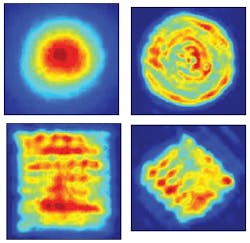
One of the most important attributes of an industrial laser is its beam profile. Some applications, such as cutting, may require the pinpoint high intensity of a single-transverse-mode Gaussian beam, while others, like surface treating, benefit from a beam with a flat-top profile. A Gaussian beam can be changed to a flat-top beam of a specific size by inserting optics such as a fly's-eye lens or a phase hologram. Any further change to the profile, however, requires a separate change of optics. Researchers at Thales Research and Technologies (Orsay, France) have taken a more dynamic approach by inserting an optically addressed liquid-crystal spatial light valve (LCLV)—a type of spatial light modulator—into a laser cavity, allowing them to change beam profile radically in less than a second.1
In the LCLV, liquid-crystal material is contained between a glass plate and a 1-mm-thick bismuth silicon oxide (BSO) crystal that serves as a photoconductive medium. Both the plate and the crystal have an inner conductive thin-film electrode of indium tin oxide. A square-wave voltage is applied to the electrodes. When spatially varying light is applied to the BSO, the crystal locally transfers voltage, changing the refractive index of the liquid crystal. The LCLV acts as a phase plate whose phase profile can be altered in real time, operating at a spatial resolution of about 100 μm.
The LCLV is inserted into the cavity of a pulsed Nd:YAG laser, diode-pumped by 100-μs pulses. To cast a modulated light pattern onto the LCLV, the light from a white-light-illuminated liquid-crystal projection display (256 gray levels, 256 x 256 pixels) is folded into the cavity and imaged onto the LCLV, with the image slightly defocused to eliminate pixellization from the projector. The phase transmission of the LCLV is monitored by a collimated He-Ne laser beam folded into and out of the system and sent to a Shack-Hartmann wavefront sensor.
First, the phase of the LCLV is optimized to produce the highest-quality laser beam. Then a one-time spatial calibration of the LCLV is carried out, resulting in a phase map induced by each gray level of the projector. The desired phase produced by the LCLV is compared to the measured phase; four iterations reduce the residual phase error to less than a tenth wave.
Starting with a Gaussian beam, the setup can produce circular and square super-Gaussian modes, both of which have flat-top profiles (see figure). Because it responds in 200 to 500 ms, the LCLV also can potentially correct thermally induced beam aberrations. The LCLV has also been used in an extracavity wavefront-correction configuration with an ultrafast laser, where the device handles 200-fs pulses at a 300-mJ/cm2 intensity, says Jérôme Bourderionnet, one of the researchers. "The intrinsic damage threshold of the device thus seems suitable for implementation in a high-power laser chain," he notes. Thales researchers are interested in pursuing further investigations to optimize device characteristics and laser performances.
REFERENCE
1. J. Bourderionnet et al., Opt. Lett. (Dec. 15, 2001).
About the Author
John Wallace
Senior Technical Editor (1998-2022)
John Wallace was with Laser Focus World for nearly 25 years, retiring in late June 2022. He obtained a bachelor's degree in mechanical engineering and physics at Rutgers University and a master's in optical engineering at the University of Rochester. Before becoming an editor, John worked as an engineer at RCA, Exxon, Eastman Kodak, and GCA Corporation.
